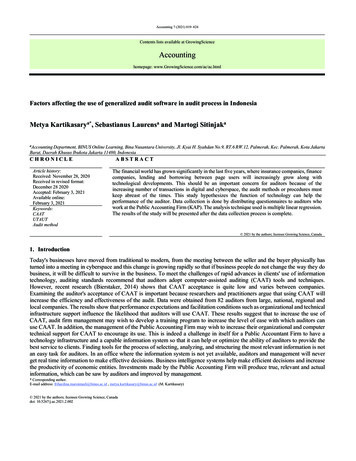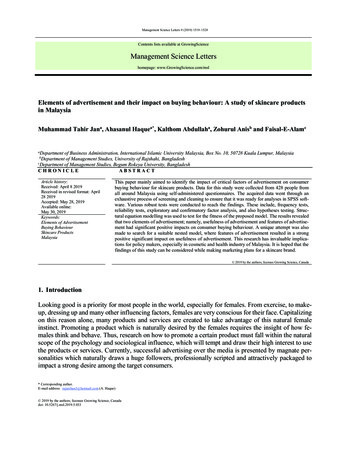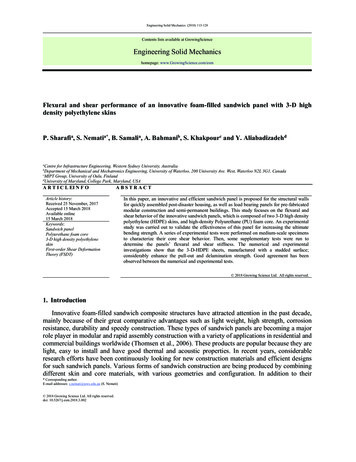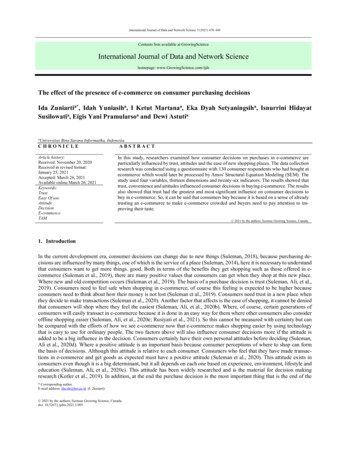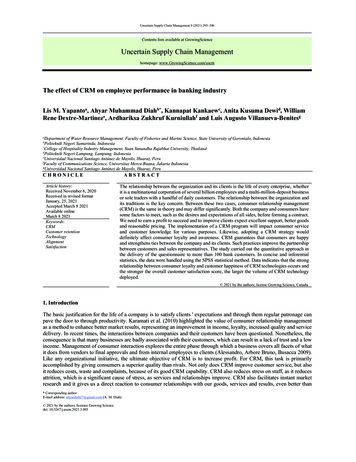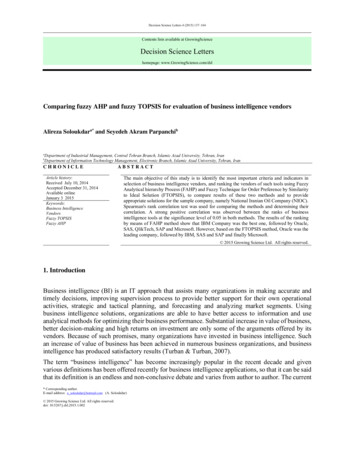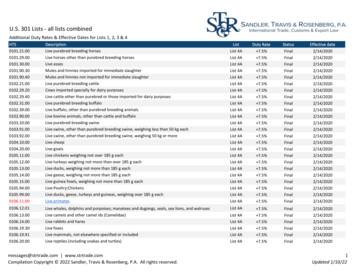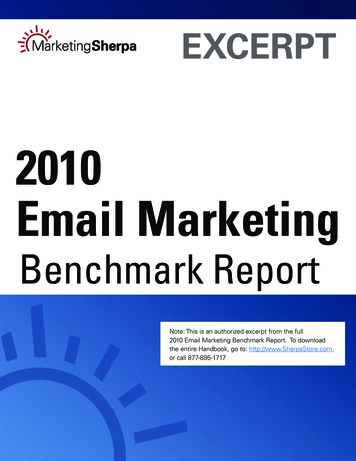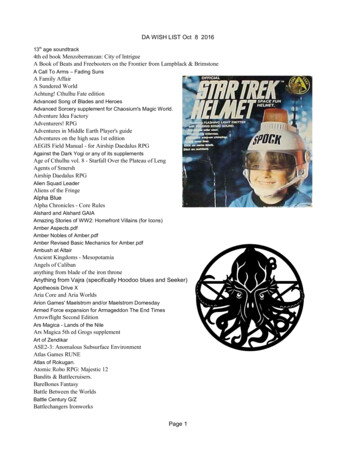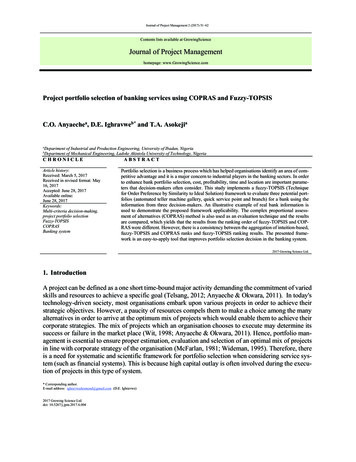
Transcription
Journal of Project Management 2 (2017) 51–62Contents lists available at GrowingScienceJournal of Project Managementhomepage: www.GrowingScience.comProject portfolio selection of banking services using COPRAS and Fuzzy-TOPSISC.O. Anyaechea, D.E. Ighravweb* and T.A. AsokejiaabDepartment of Industrial and Production Engineering, University of Ibadan, NigeriaDepartment of Mechanical Engineering, Ladoke Akintola University of Technology, NigeriaCHRONICLEArticle history:Received: March 5, 2017Received in revised format: May16, 2017Accepted: June 28, 2017Available online:June 28, 2017Keywords:Multi-criteria decision-making,project portfolio selectionFuzzy-TOPSISCOPRASBanking systemABSTRACTPortfolio selection is a business process which has helped organisations identify an area of competitive advantage and it is a major concern to industrial players in the banking sectors. In orderto enhance bank portfolio selection, cost, profitability, time and location are important parameters that decision-makers often consider. This study implements a fuzzy-TOPSIS (Techniquefor Order Preference by Similarity to Ideal Solution) framework to evaluate three potential portfolios (automated teller machine gallery, quick service point and branch) for a bank using theinformation from three decision-makers. An illustrative example of real bank information isused to demonstrate the proposed framework applicability. The complex proportional assessment of alternatives (COPRAS) method is also used as an evaluation technique and the resultsare compared, which yields that the results from the ranking order of fuzzy-TOPSIS and COPRAS were different. However, there is a consistency between the aggregation of intuition-based,fuzzy-TOPSIS and COPRAS ranks and fuzzy-TOPSIS ranking results. The presented framework is an easy-to-apply tool that improves portfolio selection decision in the banking system.2017 Growing Science Ltd.1. IntroductionA project can be defined as a one short time-bound major activity demanding the commitment of variedskills and resources to achieve a specific goal (Telsang, 2012; Anyaeche & Okwara, 2011). In today'stechnology-driven society, most organisations embark upon various projects in order to achieve theirstrategic objectives. However, a paucity of resources compels them to make a choice among the manyalternatives in order to arrive at the optimum mix of projects which would enable them to achieve theircorporate strategies. The mix of projects which an organisation chooses to execute may determine itssuccess or failure in the market place (Wit, 1998; Anyaeche & Okwara, 2011). Hence, portfolio management is essential to ensure proper estimation, evaluation and selection of an optimal mix of projectsin line with corporate strategy of the organisation (McFarlan, 1981; Wideman, 1995). Therefore, thereis a need for systematic and scientific framework for portfolio selection when considering service system (such as financial systems). This is because high capital outlay is often involved during the execution of projects in this type of system.* Corresponding author.E-mail address: ighravwedesmond@gmail.com (D.E. Ighravwe)2017 Growing Science Ltd.doi: 10.5267/j.jpm.2017.6.004
52The financial sector is considered to be very crucial to in any economy. The productivity of bank-basedfinancial service institutions impacts on every stratum of an economy. Banking is an evolutionary concern which has expanded its services to include issuance of debit and credit cards and online bankingservices. Other services of banking systems are provision of Automated Teller Machines (ATM), Pointof Sale (PoS) platforms and safe custody of valuable items among others. To capture an appreciableportion of a market, a bank must open up branches in areas where it considers strategic to the realisationof its goals and objectives. However, the choice of branch deployment projects, which a bank mayundertake in a particular financial year, is largely determined by resource availability, regulations ofthe supervising bank and government policy on construction of banks in specific areas. Other constraints to banks operations are construction approval, legal and political dynamics, disposition of hostcommunities to the project, climatic conditions and soil types among others. Therefore, there is a needfor an effective framework for evaluating, prioritising and selecting projects in line with the corporatestrategy of a bank and within its budget for the financial year.The plethora of challenges in the management of bank portfolio selection has led to several studieswhich attempt to address the problem (Paris, 2005; Saunders et al., 2007; Malek et al., 2014; Al-Halasehet al., 2016; Sirignano et al., 2016). Several attempts at addressing portfolio selection problems haveconsidered the application of Markowiz theorem (Markowiz, 1968), multi-objective linear programming, goal programming, fuzzy linear programming and linear programming models (Malek et al.,2014). Oyatoye et al. (2010) analysed Nigeria capital market using analytic hierarchy process (AHP)(Saaty, 1980). In their study, the issues of bank stability, risks and returns assessment, investment rulesand stock market portfolio were considered. Their study outcomes show that there was a need for government intervention in order to prevent the collapse of the Nigeria banking system. Agarana et al.(2014) presented a mathematical model for loan portfolio management that considered the branches,yield on loan, deposit and non-performing loans. Goal programming techniques was used to solve theirproposed model. Based on the findings of their study, it was reported that long-term mortgage was oneof the major parameters that should be considered during the management of bank’s loan portfolioanalysis. Sirignano et al. (2016) analysed the problem of large-scale loan portfolio selection using anapproximated optimisation technique. The work was able to address the issue of non-linearity and computational time of portfolio selection models. Al-Tarawneh and Khataybeh (2015) adopted Hicks’ portfolio choice theory (i.e., expected utility method) to analyze commercial banks portfolio in Jordan. Intheir study, emphasis was given to own-rate, cross-rate and interest rate as well as non-choice items.Their results revealed that assets holding of bank portfolio composition of Jordan’s bank were not affected by new banks. Malek et al. (2014) presented a linear programming approach to portfolio selection. The focus of their study was on the optimisation of facility sales. Based on their results, theydeduced that improvement in capital returns could be achieved with the use of mathematical model forbank’s portfolio selection. Misra (2011) reported a mathematical model for portfolio selection using agenetic algorithm approach. In the study, the issue of optimal values for portfolio risk and return wasinvestigated. Despite several attempts at addressing bank portfolio selection problems, sparse information on multi-criteria tools exists. This knowledge gap motivated the need for the current study. Theaim of this study study is to develop and apply fuzzy Technique for Order Preference by Similarity toIdeal Solution (TOPSIS) technique and Complex Proportional Assessment of Alternatives (COPRAS)methodology for project portfolio selection of banking services. Thus could yield the ranking of thealternatives using multiple criteria.2. Methodology2.1 Conceptual frameworkProject selection is a multi-criteria decision-making problem which includes both qualitative and quantitative factors. In order to obtain an optimal mix of projects, trade-offs are usually made between tangible and intangible factors. In project portfolio selection, deliberate efforts are made to estimate, evaluate and choose an optimal mix of projects to be executed within a given period (Anyaeche & Okwara,
C.O. Anyaeche et al. / Journal of Project Management 2 (2017)532011). Anyaeche and Asokeji (2016) employed an integrated approach involving TOPSIS (Yoon &Hwang, 1995) and AHP, to address decision making in non-precise situations. The project selectionprocess determines the optimum mix of projects. Hence, the need for a priority system to assist inselecting a mix of projects that best contributes to the organisation's objectives, within the constraintsof the resources is required (Larson et al., 2011).The project selection methods (Fig. 1) are streamlined into two main paths. The paths are benefit measurement method (comparative approach) and constrained optimisation method (mathematical approach). Benefit measurement method compares possible projects and selects the best mix of projectsexecutable. Measuring benefits realisation involves collection, consolidation and analysis of data todetermine whether stakeholders have been able to realise expected benefits from a planned change.Benefit reviews include Murder Boar, peer review, scoring models and economic models.Fig. 1. Project selection criteria (Source: Anyaeche & Asokeji, 2016)Constrained optimisation method performs mathematical calculations using various constraints and parameters to produce the probability and outcome to choose projects. Examples include linear programming, integer programming, dynamic programming, multi-object programming. Benefit measurementmethod is commonly used for project selection in banks because it uses financial criteria such as presentvalue, net present value, internal rate of return, payback period, benefit cost ratio among others to evaluate projects.The general structure of the proposed framework is shown in Fig. 2. In order to create a reliable framework, this study combines fuzzy TOPSIS and COPRAS methods outputs. A framework that integratesdifferent solution methods has the benefit of producing a good basis for sound decisions (Archer &Ghasemzadeh, 1999).
54Determine bank portfolios for a systemIdentify criteria for bank portfolio selectionDetermine the importance of the criteria using linguisticDetermine the impacts of each portfolio with respect to the criteriaRank the portfolio based on intuitive knowledgeSelect multi-criteria evaluation tool for the portfolio selection problemGenerate the ranks of the portfoliosCompare the intuition-based ranks and the multi-criteria evaluation tool ranksAggregate the various ranks and make inferenceFig. 2. Conceptual framework for bank portfolio selection2.2 Technique for Order Preference by Similarity to Ideal SolutionTOPSIS method is a goal-based decision-making approach for finding the alternative that is closest tothe ideal solution. In this method, options are graded based on ideal solution similarity. If an option ismore similar to an ideal solution, it has a higher grade. TOPSIS method is a multiple criteria methodthat is used to identify solutions from a finite set of alternatives. The basic principle is that the chosenalternative should have the shortest distance from the positive ideal solution and the farthest distancefrom the negative ideal solution. The procedure of TOPSIS is summarized as follows:(i) Calculate the normalised decision matrix. In order to generate the normalised decision matrix, thefuzzy numbers assigned to each parameter by decision makers are aggregated using Eqs. (1-4),nij1 min nijk1 (1)1 D nij 2D d 11 Dnij 3 nij 3D d 1(2)nij 2 nij 4 Max nijk 4 (3)(4)The normalised values are calculated based on the desired direction of a parameter. Parameters that arebenefit-oriented are normalised using Eq. (5), while Eq. (6) is used as the normalisation expression forcost-oriented parameter.
C.O. Anyaeche et al. / Journal of Project Management 2 (2017)nij1 , nij 2 , nij 3 , nij 4 nij1nij 2,nij 3,55nij 4,max nij 4 max nij 4 max nij 4 max nij 4 (5)min nij1 min nij1 min nij1 min nij1 jjjj,,,nij 4nij 3nij 2nij1(6)jnij1 , nij 2 , nij 3 , nij 4 jjj(ii) Calculate the weighted normalised decision matrix. To generate a weighted normalised decisionmatrix, the fuzzy weights are combined with the normalised decision matrix. First, the fuzzy numbersfor each weight with respect to the number of decision-makers are aggregated. Based on Shemshadi etal. (2011) study as well as Ighravwe and Oke (2016), the fuzzy aggregated trapezoidal numbers for acriterion is obtained using Eqs. (1-4). The expression for an alternative normalised value is given asEq. (7).xij1 , xij 2 , xij 3 , xij 4 nij1wij1 , nij 2 wij 2 , nij 3 wij 3 , nij 4 wij 4(7)(iii) Calculate the separation measures, using the n-dimensional Euclidean distance. The separation ofeach alternative from the ideal solution is given as Equations (8) and (9). The evaluation of the criteriadistances from positive ideal solutions is expressed as Equation (8), while the determination of thecriteria values from negative ideal solution is obtained using Equation (9). In this analysis, the value ofa positive ideal solution is taken as (1, 1, 1, 1), while (0, 0, 0, 0) is taken as the negative ideal solution(Wang & Elhag, 2006; Madi & Tap, 20011).Di x v j1 x v j 2 x v j 3 x v j 4 2(8)Di x v j1 x v j 2 x v j 3 x v j 4 2(9)ij1ij12ij 22ij 22ij 32ij 32ij 42ij 4(iv) Calculate the relative closeness to the ideal solution. This is carried out by considering the distances of the alternatives positive and negative ideals solutions (Eq. (10)).Ci Di Di Di (10)(v) Rank the preference order. The best-ranked alternative is the alternative with the highest relativecloseness value.2.3 COPRASThe quality of decisions during multi-criteria analysis has been aided with the use of multi-criteriatechnique including COPRAS, ANP, AHP, and TOPSIS. COPRAS method which is based on the analysis of the positive and negative outputs of alternative (Zavadskas & Kaklauskas, 1996) has not beenconsidered for bank portfolio section to the best of our understanding. COPRAS methodology has similarities with most multi-criteria tools. The first similarity is the use of normalisation expression toconvert real data into general ranges. This is necessary in order to eliminate the influence of data withlarge values on final results after the data analysis. The generally used normalisation expression forCOPRAS method is given as Eq. (11).xij xijxij2(11)
56The second similarity of COPRAS with existing multi-criteria tools is criteria weights consideration.The weights which are used during COPRAS implementation can be obtained using AHP or ANP.There is the possibility of using fuzzy weights for COPRAS implementation. This is necessary whenthe information that is used for its implementation is expressed as fuzzy numbers. A common approachfor combining weights with their respective crisp values is given as Eq. (12).x ij wi xij(12)where xij stands for the crisp value of factor j with respect to criteria i, xij stands for the normalisedvalue of factor j with respect to criteria i, and x ij stands for the weighted normalised value of factor jwith respect to criteria i.The weighted values of the information for COPRAS method implementation is used to evaluate thepositive optimisation directions of the alternatives that are being evaluated (Eq. (13)).(13)n1p j x ijj 1The values that are considered are those that contribute positively towards the attainment of the system’s objectives. Parameters whose contributions towards system goals are negative are used to compute the negative optimisation directions of the alternatives (Eq. (14)),Rj n j n1 1(14)x ijwhere Rj stands for the value of factor j negative optimisation direction, and Pj stands for the value offactor j positive optimisation direction.Based on the positive and negative optimisation directions of the alternatives, priority weights for thealternatives are determined (Eq. (15)).nQ j Pj Rjj(15)n1Rjjwhere Qj represents factor j priority weight.These weights form the basis upon which decisions are made on the most suitable solution method fora problem. To take a decision, the utility degree of each alternative is determined using Eqs. (16-17).The most suitable alternative is the alternative with the highest value of utility degree (Zolfani et al.,2012),(16)Qmax max Q j Nj QjRj 100%Qmaxwhere Nj is utility degree of alternative j.2211xij 3 xij 4 xij 2 xij1 xij 3 xij 4 xij 2 xij1 33xij xij 3 xij 4 xij 2 xij1(17)(18)
57C.O. Anyaeche et al. / Journal of Project Management 2 (2017)3. ApplicationIn this work, project portfolio selection was examined based on five inputs membership functions i.e.,five benefit and cost criteria are considered, namely project success potential (C1), profitability (C2),time (C3), location (C4) and cost (C5). Also scope with its three categories of membership functionsnamely, automated teller machine (x1) gallery, quick service point (x2) and branch (x3).Using fuzzy logic, two multi-criteria decision-making techniques were used namely, AHP and TOPSIS.A committee of three decision-makers (D1, D2, and D3) was constituted to select the most suitableprojects from the options proposed for implementation in a given financial year. D1 the chief financialofficer, D2 the chief strategy officer (CSO) and D3 the Head, General Services.Data were collected from Mafabet bank, with over 700 branches nationwide. Usually, most projectselection decisions are taken at top management and middle management level without due recourse toappropriate project portfolio selection techniques. Consequently, some of the projects decisions maybe at variance with a strategic goal of the bank. About forty per cent of construction projects undertakenis observed to overrun in terms of scope, time or cost. One of the major causes of this high rate ofproject failure is traceable to the use subjective and vague criteria in selecting project portfolio (Westney, 2004).Table 1Weighted decision ratingLinguistic termsVery lowLowMedium lowMediumMedium highHighVery highTable 2Weighted decision matrixCriterionC1C2C3C4C5Trapezoidal fuzzy number(0, 0, 0.1, 0.2)(0.1, 0.2, 0.2, 0.3)(0.2, 0.3, 0.4, 0.5)(0.4 ,0.5, 0.5, 0.6)(0.5, 0.6, 0.7, 0.8)(0.7, 0.8, 0.8, 0.9)(0.8, 0.9, 1, 1)D1(0.7, 0.8, 0.8, 0.9)(0.8, 0.9, 1, 1)(0.8, 0.9, 1, 1)(0.7, 0.8, 0.8, 0.9)(0.7, 0.8, 0.8, 0.9)D2(0.7, 0.8, 0.8, 0.9)(0.8, 0.9, 1, 1)(0.8, 0.9, 1, 1)(0.7, 0.8, 0.8, 0.9)(0.7, 0.8, 0.8, 0.9)Table 3Aggregated fuzzy trapezoidal number for the criterionwij1wij 870.800.80D3(0.7, 0.8, 0.8, 0.9)(0.8, 0.9, 1, 1)(0.7, 0.8, 0.8, 0.9)(0.7, 0.8, 0.8, 0.9)(0.7, 0.8, 0.8, 0.9)wij 3wij 40.801.000.930.800.800.901.001.000.900.90
58Table 3 was transformed from the ratings of the three project types (ATM, branch and QSP) by thedecision makers under all criteria with the following rating scale:Table 4Linguistic terms and fuzzy numbers for the portfolio ratingLinguistic termsVery poorPoorMedium poorFairMedium goodGoodVery goodTrapezoidal fuzzy number0, 0, 1, 21, 2, 2, 32, 3, 4, 54, 5, 5, 65, 6, 7, 87, 8, 8, 98, 9, 10, 10Three decision makers used the linguistic rating variables to evaluate the ratings of projects with respectto each criterion. The results are summarized in Tables 5-6.Table 5The ratings of the three VGVGVGVGVGx3VGVGGVGGGVGVGGVGVGVGGVGGx1(5, 6, 7, 8)(7, 8, 8, 9)(8, 9, 10, 10)(5, 6, 7, 8)(8, 9, 10, 10)(8, 9, 10, 10)(7, 8, 8, 9)(8, 9, 10, 10)(8, 9, 10, 10)(7, 8, 8, 9)(7, 8, 8, 9)(8, 9, 10, 10)(7, 8, 8, 9)(8, 9, 10, 10)(7, 8, 8, 9)x2(5, 6, 7, 8)(7, 8, 8, 9)(8, 9, 10, 10)(5, 6, 7, 8)(8, 9, 10, 10)(7, 8, 8, 9)(7, 8, 8, 9)(8, 9, 10, 10)(8, 9, 10, 10)(7, 8, 8, 9)(8, 9, 10, 10)(8, 9, 10, 10)(7, 8, 8, 9)(8, 9, 10, 10)(8, 9, 10, 10)x3(5, 6, 7, 8)(7, 8, 8, 9)(7, 8, 8, 9)(8, 9, 10, 10)(8, 9, 10, 10)(7, 8, 8, 9)(7, 8, 8, 9)(8, 9, 10, 10)(7, 8, 8, 9)(7, 8, 8, 9)(8, 9, 10, 10)(8, 9, 10, 10)(7, 8, 8, 9)(8, 9, 10, 10)(7, 8, 8, 9)Table 6Fuzzy decision 1D2D3
59C.O. Anyaeche et al. / Journal of Project Management 2 (2017)Table 7Fuzzy aggregated decision matrixx1C1C2C3C4C5x2x3xij1xij 2xij 3xij 4xij1xij 2xij 3xij 4xij1xij 2xij 3xij 10.00During the normalisation of the criteria, C1, C2 and C4 were considered as benefit-based criteria, whileC3 and C5 were taken as cost-based criteria. The weighted normalised values for the portfolio wereobtained using the information in Tables (3-8) alongside.Table 8Normalised decision matrixx1xij1xij 2xij 3xij 80.830.900.580.870.60x21.001.001.001.001.00Table 9Weighted normalised decision matrixx1xij1xij 2xij 3xij 60.670.900.540.690.480.901.001.000.900.90xij 2xij 3xij 4xij1xij 2xij 3xij .711.000.71xij1xij 2xij 3xij 4xij1xij 2xij 3xij .710.900.64x2Table 10Distances of the criteria from positive ideal 92240.63770.9928Table 11Distances of the criteria from negative ideal 831.3292x31.49902.79311.19602.08830.9792
60Table 12Final outputs from the fuzzy TOPSIS methodx1 Di3.6944 50.7090The information in Table 11 was used to implement the COPRAS method that was discussed in section2.3. The weighted normalised fuzzy numbers were converted into crisp values (Table 13).Table 13Crisp values of the criteria for COPRAS 51.01873.3401Table 14COPRAS outputs for portfolio selectionx12.01981.18343.0843PjRjQjThe utility degree of the various alternatives for the bank portfolio selection was determined using theinformation in Table 16. In terms of utility degree, the best ranked alternative for the bank portfolioselection problem was x3 (100%), while x2 was the second-ranked alternative with a utility degree valueof 93.80%. A value of 92.34% was obtained as the utility degree of x1.3.1. A comparison of Fuzzy-TOPSIS and COPRAS resultsThe comparison of the results from the fuzzy-TOPSIS and COPRAS methods are shown in Fig. 4. Theresults have shown that the selection methods gave different ranking orders for bank portfolio selection.In order to obtain the final ranks for the portfolios, the default, fuzzy TOPSIS and COPRAS rankingresults were aggregated. Based on the aggregated ranks, the best portfolio for the case study is quickservice point (x2), while the opening of a branch is the least attract option (x3). The results obtainedfrom this study have shown that portfolio selection results should be based on more than one selectionmethods.4x1Rank3x2x3210DefaultFuzzy TOPSISCOPRAS RankSolution m ethodsFig. 3. Comparison of portfolio selection methods
C.O. Anyaeche et al. / Journal of Project Management 2 (2017)614. ConclusionsThe development and application of a multi-criteria framework for bank portfolio selection was pursued in this stud غ . This was achieved by proposing a framework that considered fuzzy logic and TOPSIS as a selection tool. The applicability of the proposed framework was verified using informationobtained from a bank. Three decision-makers were considered during the proposed framework application. Based on the results obtained, it was observed that the proposed framework has the capacity toidentify the best and worst portfolios for a bank.Furthermore, the results obtained from the fuzzy-TOPSIS method were compared with COPRASmethod and decision-makers’ intuitions. It was observed that the ranking methods did not give the sameresults. However, the proposed framework addressed the discrepancies in results by aggregating thevarious ranks from the ranking methods. The aggregated results were consistent with the fuzzy TOPSISresults.The consideration of fuzzy axiomatic design principles for bank portfolio could be pursued as a furtherstudy.ReferencesAgarana, M.C., Bishop, S.A., & Odetunmibi O.A. (2014). Optimisation of banks loan portfolio management using goal programming technique. International Journal of Research in Applied, Naturaland Social Sciences, 2(8), 43-52.Al-Halaseh, R.H.S., Islam, Md. A., & Bakar R. (2016). Dynamic portfolio selection: A literature revisit.International Business management, 10(2), 67-77.Al-Tarawneh, A., & Khataybeh M. (2015). Portfolio behaviour of commercial banks: the expectedutility approach: evidence from Jordan. International Journal of Economics and Financial Issues,5(2), 312-323.Anyaeche, C.O., & Asokeji, T.D. (2016). An integrated fuzzy-based AHP and TOPSIS models in project portfolio selection of banking services, Journal of Nigerian Institute of Industrial Engineers, 5,19-36.Anyaeche, C.O., & Okwara, R.A. (2011). An integer linear programming model for project portfolioselection in a community. International Journal of Engineering Research in Africa, 4, 67-74.Archer, N.P., & Ghasemzadeh, F. (1999). An integrated framework for project portfolio selection. International Journal of Project Management, 17(4), 207-216.Ighravwe, D.E., & Oke S.A. (2016). A multi-attribute framework for determining the competitive advantages of products for business survival: A fuzzy TOPSIS approach. Total Quality Managementand Business Excellence, 48.Larson, C. P., Koehlmoos, T. P., Sack, D. A., & Scaling Up of Zinc for Young Children (SUZY) ProjectTeam. (2011). Scaling up zinc treatment of childhood diarrhoea in Bangladesh: theoretical and practical considerations guiding the SUZY Project. Health policy and planning, 27(2), 102-114.Madi, E.N., & Tap, A.O.M. (2011). Fuzzy TOPSIS method in the selection of investment boards byincorporating operational risks. Proceedings of the World Congress on Engineering 2011, WCE2011, July 6 - 8, 2011, London, U.K.Malek, H., Emamverdi, G., & Kashani, M.S. (2014). Selecting an optimal resource allocation model toconsumptions in banks of Iran. International Journal of Academic Research in Business and SocialSciences, 4(3), 204-213.Markowitz, H. M. (1968). Portfolio selection: efficient diversification of investments (Vol. 16). Yaleuniversity press.McFarlan, F.W. (1981). Portfolio approach to information systems. Harvard Business Review, SeptOct, 142-150.
62Misra, A.K. (2011). Optimisation of return under risk constraint: An application on Indian banks. 2011International Conference on Financial Management and Economics, IPEDR, Vol.11 (2011),IACSIT Press, Singapore.Oyatoye, E.O., Okpokpo, G.U., & Adekoya, G.A. (2010). An application of AHP to investment portfolio selection in the banking sector of the Nigerian capital market. Journal of Economics and International Finance, 2(12), 321.Paris, F. (2005). Selecting an optimal portfolio of consumer loans by applying the state preferenceapproach. European Journal of Operational Research, 163(1), 230-241.Pinto, J.K., & Mantel, S.J. (1990). The causes of project failure. IEEE Transactions on EngineeringManagement, 37(4), 269-276.Saaty, T. L. (1980). Analytic hierarchy process. John Wiley & Sons, Ltd.Saunders, D., Xiouros, C., & Zenios, S. (2007). Credit risk optimisation using factor model. Annalsof Operations Research, 152(1), 49-77.Shemshadi, A., Shirazi, H., Toreihi, M., & Tarokh, M. J. (2011). A fuzzy VIKOR method for supplierselection based on entropy measure for objective weighting. Expert Systems with Applications, 38(10), 12160-12167.Sirignano, J. A., Tsoukalas, G., & Giesecke, K. (2016). Large-scale loan portfolio selection. OperationsResearch, 64(6), 1239-1255Telsang, M. (2012). Industrial Engineering and Production Management. 11th ed. New Delhi: S.Chand & Company Ltd.Wang, Y. M., & Elhag, T. M. (2006). Fuzzy TOPSIS method based on alpha level sets with an application to bridge risk assessment. Expert systems with applications, 31(2), 309-319.Westney, R.E. (2004). Managing the Engineering and Construction of Small Projects. Marcel Dekker,Inc.Wideman, R.M. (1995). Criteria for a project-management body of knowledge. International Journalof Management, 13(2), 71-75.Wit, A. (1988). Measurement of project success. International Journal of Project Management, 6(3),164-170.Yoon, K. P., & Hwang, C. L. (1995). Multiple attribute decision making: an introduction (Vol. 104).Sage publications.Zavadskas, E.K., & Kaklauskas, A. (1996). Multiple Criteria Evaluation of Buildings. Technika, Vilnius (in Lithuanian).Zavadskas, E.K., Turskis, Z., Tamosaitiene, J., & Marina, V. (2008). Selection of Construction ProjectManagers by Applying COPRAS-G Method. The 8th International Conference Reliability and Statistics in Transportation and Communication - 2008, 344-350.Zolfani, S.H., Rezaeiniya, N., Aghdaie, M.H., & Zavadskas, E.K. (2012). Quality control managerselection based on AHP-COPRAS-G methods: a case in Iran. Economic Research-EkonomskaIstrazivanja, 25(1), 72-86. 2017 by the authors; licensee Growing Science, Canada. This is an open access article distributed under the terms and conditions of the Creative Commons Attribution(CC-BY) license (http://creativecommons.org/licenses/by/4.0/).
proposed model. Based on the findings of their stu dy, it was reported that long-term mortgage was one of the major parameters that should be considered during the management of bank's loan portfolio analysis. Sirignano et al. (2016) analysed the problem of large-scale loan portfolio selection using an approximated optimisation technique.
